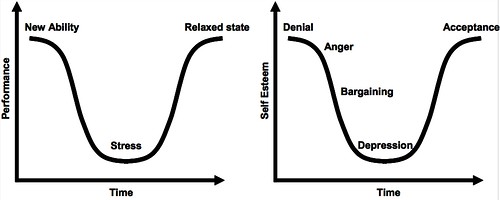Beauty is in the eye of the beholder. Instead of evaluating a change situation from a ‘Death and Dying’ perspective, I would suggest to look at it from the ‘Life and Birthing’ perspective.
Organizational change practitioners who are acquainted with the literature on change management know that I am referring to Elisabeth Kuebler Ross, who stated that dying underwent five stages. Although I think that the stages are surprisingly accurate in describing what is going on and what will come next during a change, I suspect we could do better if we look at these stages from a birthing perspective.
Same Cycle, Different Angle
It is striking how the major insights of the change cycle come from two angles that seem at first to be opposites: development psychology, and research on death and dying. Psychologists and biologists observed that we typically find children whining and being more difficult when they learn something new and it often takes a while before they adapt to and assimilate these new abilities. For human development “things will get worse before they get better” is almost a law of nature: A biological upgrade of our brain software leads to a drop in performance before we pick up and use our new- found abilities.
On the complete other side of the spectrum, Elisabeth Kuebler Ross has described her work with terminally ill patients and found that they typically come to terms with their prognosis in five stages: denial, anger, bargaining, depression, and finally acceptance. In these cases, it is self- esteem that shows a serious drop-off and then picks up with acceptance in the same way as an infant coming to terms with its new abilities. Although most organizational change is not of a life-or-death nature, people may experience similar stages as they adjust to it, making Kuebler Ross’ advice highly applicable.
Looking at the change cycles in the figures above, it is remarkable that our field of expertise has taken the death-curve as a frame of reference. This is even more striking because the child-development perspective dates from 30 years before Elisabeth Kuebler Ross’ fieldwork.
Birthing
In an earlier article I have referred to Jean Piaget – who is generally regarded as the father of child-psychology. Piaget was the first to discover that during each new stage of development, the child’s brain-mind is prepared for the new potentials appropriate to that stage of growth. If appropriate models for those potentials are given in a safe space, learning is automatic, spontaneous and natural.
Before a child is born, there is a magical interplay of stress hormones in the bodies of the mother and the child that cause the birthing process to kick-off. The next thing you know is that childbirth goes through different stages that can equally be compared to what people go though during an organizational change. In my opinion the metaphor of birthing (instead of dying) contains far more possibilities in the context of an organizational change. Here are some examples:
- Contractions: these are the first signs of a point of no return. Contractions are painful (so I’m told) and both mother and child are going through an intense period of stress. There will be blood everywhere. There is no such thing as a clean birth. It’s unavoidable.
- The umbilical cord: It’s the cord that gives life to the child and the channel through which the child has been given strength during pregnancy. The umbilical cord symbolizes the relationship between the owner and the future state (be it a new organization structure or an ERP platform). In most organizations the future state is strengthened by external project teams, giving little possibility for a natural umbilical cord to do the work.
- Vernix: procrastination, grapevine and whining are a necessary catalyst in the birthing of a future state. It’s the vernix that is necessary for our own protection and that is useful during the process of birthing. And just like vernix it looks ugly. You don’t need to wash it off because the skin of the newborn will absorb all of it.
- Wombing: How’s that for a new verb? With ‘wombing’ I refer to the need of a mother (a future owner) to have a child-wish, to conceive the child voluntarily and to have an intense bonding with the child even before it is born. The bonding that occurs during pregnancy convinces the mother that the contractions and the labor ar worth it.
- 9 months of pregnancy: Time and again we see project managers trying to make 9 woman pregnant in order to deliver a baby in 1 month. It happens over and over – and every time these project managers run into the wall of time.
I am sure that you can think of much more possibilities that come to life with this metaphor and I invite you to share them in the comments section. I am convinced that a 2 hour brainstorm may result in a sparking and inspiring document detailing every aspect of the birthing process in terms of organizational change.
The Point (and the Disclaimer)
The point I am trying to make in this article is that both perspectives describe a cycle where ‘things will get worse before they get better’. It’s a law of nature. This article is an invitation to look at a same change situation from a different perspective. This will not change the nature of things – the cycle remains the same – but it will fundamentally alter the conclusions and actions that we draw from it.
And finally: a big disclaimer. The fieldwork of Elisabeth Kuebler Ross is unique and will continue to be one of the fundaments of our field of expertise. There is no way that I am doubting its validity or added value.




